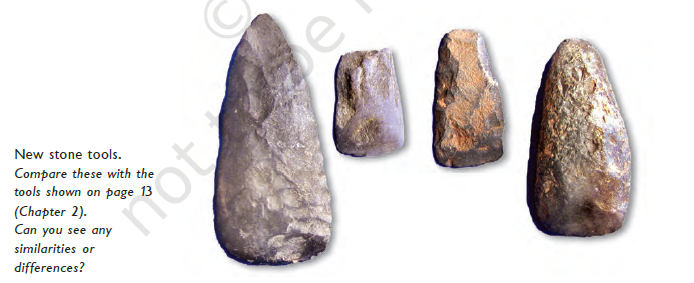Chapter 3: From Gathering to Growing Food | 07 Nov 2025
The Beginning of Farming and Herding
- For thousands of years, humans lived as hunter-gatherers, collecting wild plants and hunting animals.
- Around 8,000 years ago, some people began to grow plants and rear animals, marking the Neolithic Revolution.
- This transition from food gathering to food production was gradual and regionally varied.
- People selected plants and animals that were domesticated for their desirable traits (e.g., easy to grow, tame behavior).
Domestication
- Domestication: Process in which people grow plants and look after animals.
- Domesticated animals: Dog, sheep, goat, cattle, and pig – used for milk, meat, and labour.
- Domesticated plants: Mainly wheat and barley, later rice and millet.
- Earliest evidence: Found at Mehrgarh (present-day Pakistan).
- Domesticated animals were often smaller than wild ones and lived close to humans.
Sites of Early Farming and Herding
|
Archaeological Site |
Present-day Location |
Grains / Animal Remains Found |
|
Mehrgarh |
Pakistan |
Wheat, Barley, Sheep, Goat, Cattle |
|
Koldihwa |
Uttar Pradesh |
Rice, Fragmentary Animal Bones |
|
Mahagara |
Uttar Pradesh |
Rice, Cattle (Hoof Marks on Clay Surface) |
|
Gufkral |
Kashmir |
Wheat, Lentil |
|
Burzahom |
Kashmir |
Wheat, Lentil, Dog, Cattle, Sheep, Goat, Buffalo |
|
Chirand |
Bihar |
Wheat, Green Gram, Barley, Buffalo, Ox |
|
Hallur |
Andhra Pradesh |
Millet, Cattle, Sheep, Goat, Pig |
|
Paiyampalli |
Andhra Pradesh |
Black Gram, Millet, Cattle, Sheep, Pig |
A New Way of Life
- Beginning of Agriculture:
- People began growing plants, which required them to stay in one place for long periods.
- Activities included watering, weeding, and protecting crops from animals and birds until the grain ripened.
- Marked the transition from nomadic to settled life.
- Storage of Grain :
- After harvesting, grain was used for food and seed, so it needed to be stored safely.
- Storage methods included:
- Large clay pots
- Woven baskets
- Pits dug into the ground
- Development of storage indicates planned food management.
- ‘Storing’ Animals :
- People began rearing animals, which served as a store of food.
- Animals provided milk, meat, and could multiply naturally.
- Other uses included hides (leather), wool, manure, and help in transport or ploughing.
- Marked the beginning of animal domestication and pastoral life.
- Evidence of Early Farmers and Herders :
- Sites of early agriculture and herding found across the Indian subcontinent.
- Important regions:
- North-West (Mehrgarh)
- Kashmir Valley (Burzahom, Gufkral)
- East India (Chirand)
- South India (Hallur, Paiyampalli)
- Evidence includes plant remains and animal bones.
- Burnt grains found -possibly accidental or ritualistic burning.
- Scientists identified different crops (wheat, barley, rice, lentil, millet) and domesticated animals (cattle, sheep, goat, buffalo, pig).
Towards a Settled Life
- Archaeologists found traces of huts or pit-houses (e.g., Burzahom, Kashmir).
- Pit-houses were dug into the ground with steps leading in, suitable for cold climates.
- Cooking hearths found inside and outside huts, suggesting seasonal cooking practices.
- Neolithic Tools:
- New kinds of tools appeared:
- Polished stone tools with a fine cutting edge.
- Mortars and pestles for grinding grains and plants.
- Old Palaeolithic tools continued to be used alongside new ones.
- Some tools were also made of bone.
- New kinds of tools appeared:
Other Customs and Practices
- Archaeology cannot directly reveal customs or beliefs. Scholars study present-day tribal societies practising simple farming and herding for insights.
- These groups often follow ancient traditions, suggesting continuity of cultural practices from early farming communities.
Tribes
- Structure: Consist of related families living together in small villages for two to three generations.
- Occupations:
- Engage in hunting, gathering, farming, herding, and fishing.
- Women handle most farm work (sowing, harvesting, grinding); men manage herds; children guard crops and small flocks.
- Both sexes make pots, baskets, tools, huts, and join in music, dance, and decoration.
- Leadership:
- Leaders may be experienced elders, warriors, or priests.
- Elderly women were respected for wisdom.
- Culture and Beliefs: Have distinct languages, songs, stories, art, and local deities.
- Social System:
- Land, water, and forests are shared tribal property.
- Society shows equality, no rich-poor divide, emphasizing collective ownership.
Mehrgarh
- Location: Near the Bolan Pass, linking Indus plains with Iran and Afghanistan.
- Economy:
- Agriculture and animal rearing.
- Wheat and barley cultivation was common.
- Burials: Some graves had ornaments and tools, showing social differences.
- Crafts:
- Evidence of beads, shells, ornaments, and terracotta figurines.
- Indicates emergence of specialized craftspeople.
- Trade: Linked with distant regions via Bolan Pass trade route.
Daojali Hading
- Location: Situated in the hills near the Brahmaputra Valley, close to routes leading into China and Myanmar.
- Findings:
- Discovery of stone tools, including mortars and pestles.
- Indicates that people were probably growing grain and preparing food.
- Presence of jadeite, a stone likely brought from China, suggesting long-distance contact or trade.
- Finds also include tools made of fossil wood (ancient wood hardened into stone) and pottery.
Catal Huyuk (Turkey)
- Location: A major Neolithic site in present-day Turkey.
- Trade and Exchange: Materials like flint from Syria, cowries from the Red Sea, and shells from the Mediterranean Sea were found.
- Indicates long-distance trade and exchange networks during the Neolithic period.
- Transportation:There were no carts; goods were carried on pack animals (like cattle) or by people.

